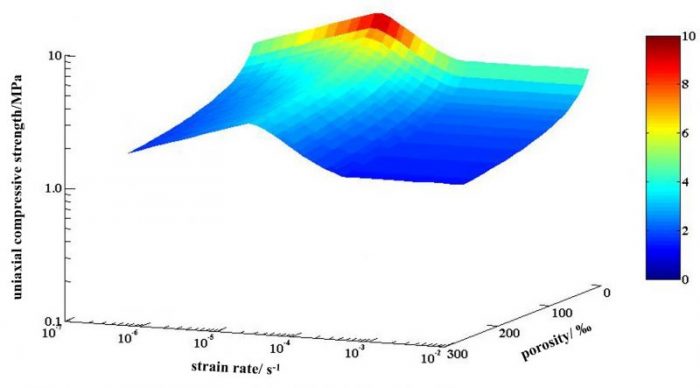
The Arctic Ocean is undergoing a series of changes in sea ice, whose concentration and thickness, as well as multiyear ice volume, has decreased significantly. These changes have made the Arctic region more and more accessible and have attracted numerous scholars to concentrate on the spatial and temporal distribution of sea ice.
The physical and mechanical properties of Arctic sea ice are less focused; however, they are the key ice characteristics if an icebreaker wants to go through the ice-covered sea safely.
Sea ice is a complex material which is made up of pure ice, brine, and air. The latter two are of no strength, thus, the strength of sea ice is mainly controlled by the volume fraction of brine and air, i.e. porosity. And the porosity can be calculated using ice temperature, salinity, and density. In order to reveal the physical and mechanical properties of Arctic sea ice under the current situation, the ice temperature, salinity, density, and uniaxial compressive strength were measured in a field investigation by Qingkai Wang, Zhijun Li, Ruibo Lei, and Hongwei Han.
R/V Xuelong is the Chinese icebreaker which navigated into the central area of the Arctic Ocean twice in 2014 and 2016, and it conducted field investigations on ice. Several ice cores were extracted using ice drillers, then ice temperature, salinity, and density were measured. Afterward, the rest of the ice cores were transported to an onboard cryogenic laboratory to measure the uniaxial compressive strength.
During melt season, Arctic sea ice temperature decreased with depth and ranged between −1.2°C and −0.2°C. Ice salinity increased with depth and was mostly less than 4 PSU. The salinity at the top was close to 0 PSU because of downward brine drainage. Ice density also increased with depth from top to bottom, mostly ranging from 600 kg/m3 to 980 kg/m3. Both air and brine volume fractions ranged mainly between 0 and 300‰, while the former decreased with depth and the latter increased with depth, which made air volume more than brine volume at the top of an ice sheet, while less than brine volume at the bottom. Ice porosity ranged mainly between 50‰ and 400‰.
As mentioned previously, porosity is a critical parameter affecting sea ice strength. The more the porosity, the less strong the sea ice is. The results of the uniaxial compressive test showed that the sea ice strength decreased with increasing porosity in a powered manner. Besides, test results showed that sea ice strength is also a function of the strain rate, which is relevant to loading speed. At a low loading speed, the strength increased with increasing strain rate in a powered manner, while it decreased with increasing strain rate in a quadratic function manner at higher loading speed regime. However, with loading speed increasing continuously, the strength tends to be independent with strain rate. Therefore, a parameterization of uniaxial compressive strength can be established using porosity and strain rate as parameters, as shown in Figure 2.

Variation of uniaxial compressive strength with strain rate and porosity. Image credit: Qingkai Wang
This work built a bridge between the mechanics and physics of Arctic sea ice. Therefore, the parametric model proposed in this study may be useful to estimate the uniaxial compressive strength of Arctic sea ice in this changing environment.
These findings are described in the article entitled Estimation of the uniaxial compressive strength of Arctic sea ice during melt season, recently published in the journal Cold Regions Science and Technology. This work was conducted by Qingkai Wang and Zhijun Li from the Dalian University of Technology in China, Ruibo Lei from the Polar Research Institute of China, and Hongwei Han from the Northeast Agriculture University in China.









